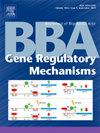ARID1A-driven modulation of EZH2 impedes proliferation and enhances senescence in breast cancer cells
IF 3.1
3区 生物学
Q3 BIOCHEMISTRY & MOLECULAR BIOLOGY
Biochimica et Biophysica Acta-Gene Regulatory Mechanisms
Pub Date : 2025-06-19
DOI:10.1016/j.bbagrm.2025.195102
引用次数: 0
Abstract
ARID1A mutations, in association with EZH2 overexpression, are linked to various malignancies, particularly those driven by epigenetic dysregulation and associated with therapy resistance. The prevalence of ARID1A mutations is high in ER+ breast cancer, and studies have mainly explored the synthetic lethal effects of these proteins. However, the tumor-suppressive mechanisms of ARID1A are complex and not yet fully understood. In this study, we explored the potential tumor-specific epigenetic antagonism between ARID1A and EZH2 in breast cancer cells, particularly focusing on the modulation of EZH2 by ARID1A through senescence pathway activation. Treatment with DNA-damaging agents induced senescence, which was associated with upregulation of ARID1A expression and a concurrent reduction in EZH2 levels, suggesting a potential role for ARID1A in the induction and maintenance of the senescence phenotype. Overexpression of ARID1A led to reduced EZH2 levels, suppressed cell proliferation in MCF-7 and MDA-MB231 cells, and induced a senescence-like phenotype. These cells exhibited changes in cell-to-cell adhesion, increased filopodium formation, and G0/G1 cell cycle arrest. This antiproliferative effect of ARID1A is mediated through the activation of the p53-p21/p16 axis. Furthermore, ARID1A knockdown-associated downregulation of EZH2 highlights the integral role of ARID1A in destabilizing the expression of EZH2 and contributing to cell cycle arrest. Importantly, we found that dasatinib treatment selectively targeted tumor cells overexpressing ARID1A. These findings provide preliminary insight into the molecular mechanisms by which ARID1A regulates EZH2 and establishes a senescence phenotype, offering valuable directions for developing more effective and personalized treatments.

arid1a驱动的EZH2调控可抑制乳腺癌细胞的增殖并促进衰老。
与EZH2过表达相关的ARID1A突变与各种恶性肿瘤有关,特别是那些由表观遗传失调驱动并与治疗耐药性相关的恶性肿瘤。ARID1A突变在ER+乳腺癌中的患病率很高,研究主要探讨这些蛋白的合成致死作用。然而,ARID1A的肿瘤抑制机制是复杂的,尚未完全了解。在这项研究中,我们探索了ARID1A和EZH2在乳腺癌细胞中潜在的肿瘤特异性表观遗传拮抗作用,特别关注了ARID1A通过衰老途径激活对EZH2的调节。dna损伤剂处理诱导衰老,这与ARID1A表达上调和EZH2水平降低相关,提示ARID1A在诱导和维持衰老表型中可能起作用。ARID1A的过表达导致EZH2水平降低,抑制MCF-7和MDA-MB231细胞的细胞增殖,并诱导衰老样表型。这些细胞表现出细胞间粘附的变化,丝足形成增加,G0/G1细胞周期停滞。ARID1A的这种抗增殖作用是通过激活p53-p21/p16轴介导的。此外,ARID1A敲低相关的EZH2下调强调了ARID1A在破坏EZH2表达稳定和促进细胞周期阻滞中的整体作用。重要的是,我们发现达沙替尼治疗选择性靶向过表达ARID1A的肿瘤细胞。这些发现初步揭示了ARID1A调控EZH2并建立衰老表型的分子机制,为开发更有效和个性化的治疗方法提供了有价值的指导。
本文章由计算机程序翻译,如有差异,请以英文原文为准。
求助全文
约1分钟内获得全文
求助全文
来源期刊
CiteScore
9.20
自引率
2.10%
发文量
63
审稿时长
44 days
期刊介绍:
BBA Gene Regulatory Mechanisms includes reports that describe novel insights into mechanisms of transcriptional, post-transcriptional and translational gene regulation. Special emphasis is placed on papers that identify epigenetic mechanisms of gene regulation, including chromatin, modification, and remodeling. This section also encompasses mechanistic studies of regulatory proteins and protein complexes; regulatory or mechanistic aspects of RNA processing; regulation of expression by small RNAs; genomic analysis of gene expression patterns; and modeling of gene regulatory pathways. Papers describing gene promoters, enhancers, silencers or other regulatory DNA regions must incorporate significant functions studies.

 求助内容:
求助内容: 应助结果提醒方式:
应助结果提醒方式:


